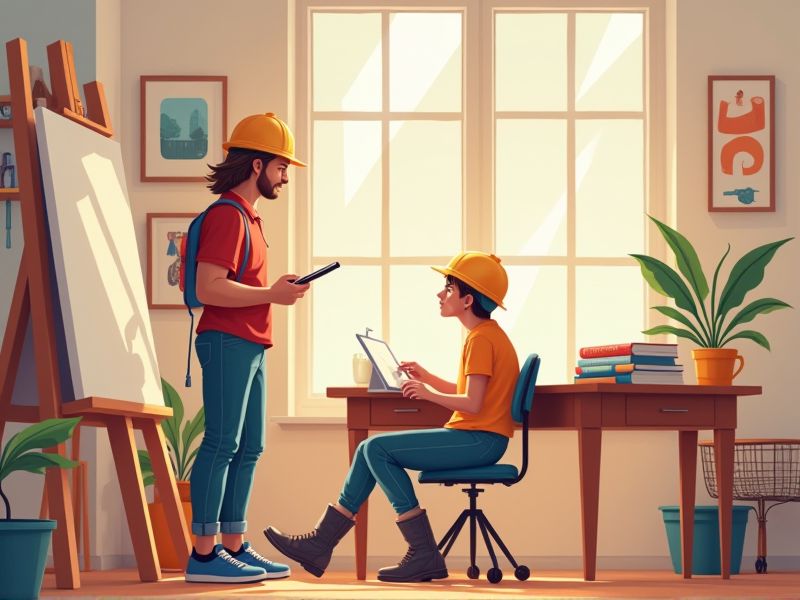
To improve at drawing, one must focus on seeing correctly, as Kimon Nicolaides emphasizes: "Learning to draw is really a matter of learning to see - to see correctly - and that means a good deal more than merely looking with the eye" . This approach highlights the importance of perception over mere observation. Camille Pissarro also notes that consistent practice is key, stating, "It is only by drawing often, drawing everything, drawing incessantly, that one fine day you discover, to your surprise, that you have rendered something in its true character" . By combining these insights, artists can refine their skills and capture the essence of their subjects more effectively.
How To Be Better At Drawing
Practice regularly.
Consistent drawing practice gradually refines your technique by reinforcing muscle memory and enhancing precision. Regular sessions expose you to different challenges, promoting continuous improvement and creative experimentation. Establishing a routine helps identify both strengths and weaknesses, allowing targeted skill development over time. As your confidence grows through persistent practice, you build a strong foundation that inspires further artistic exploration.
Refine fundamental skills.
Develop a routine that challenges you to master basic shapes, perspective, light, and shadow. Consistently practicing these elements builds a precise technical foundation that directly enhances overall drawing skills. By focusing on fundamental principles, you observe measurable improvements in accuracy and visual storytelling. This methodical refinement transforms foundational knowledge into advanced creative expression over time.
Study anatomy.
Studying anatomy reveals the structural foundation that governs how bodies move and interact, leading to more accurate and dynamic drawings. A deep understanding of muscles, bones, and their interrelationships enhances your ability to capture lifelike proportions and realistic poses. This knowledge not only informs line work but also improves your grasp of shading and volume, contributing directly to the depth of your artwork. Dedicating time to both theoretical study and practical sketches of anatomical structures creates a strong, data-driven base for continuous improvement in drawing skills.
Master perspective.
To improve your drawing skills, focus on mastering perspective techniques like one-point, two-point, and even three-point perspective. Understanding and applying these methods creates an illusion of depth and makes your images more lifelike. Regular practice using perspective grids and sketching scenes from multiple angles reinforces spatial accuracy over time. Emphasizing perspective not only builds solid foundational skills but also transforms simple sketches into dynamic visuals.
Use quality references.
Using quality references provides detailed visual information, enabling you to capture subtle nuances like texture, lighting, and anatomy more accurately. Observing these clear details helps refine your perception of perspective and proportion, critical elements that enhance the realism of your drawings. High-quality sources also boost your confidence by offering reliable data that can be consistently applied across different projects. Integrating these references into your routine practice creates a feedback loop, reinforcing precision and fostering continuous improvement in your drawing skills.
Experiment with mediums.
Experimenting with different drawing mediums introduces fresh techniques and perspectives that can elevate your skills. Each medium, whether it's graphite, charcoal, ink, or digital tools, offers unique challenges and rewards that push you to refine your method. Data indicates that regularly trying new mediums not only sparks creativity but also enhances your understanding of light, texture, and contrast in your work. Embracing a variety of tools cultivates versatility and accelerates artistic growth by turning experimental failures into structured learning opportunities.
Develop observational skills.
Sharpening your ability to draw starts with enhancing your observational skills because it strengthens how you perceive details and proportions. Focusing intently on everyday objects trains your brain to identify subtle shapes and textures that can later be transferred onto paper. As you become more accurate in observing, your drawing techniques naturally improve, leading to more realistic creations. This improvement in observational capabilities directly increases your overall confidence and consistency in drawing.
Embrace constructive critique.
Practice regularly to refine your hand-eye coordination and develop your unique style. Invest time in studying composition, light, and shadow to add depth and realism to your work. Embrace constructive critique to pinpoint areas of improvement and ascertain how subtle changes can elevate your drawings. Analyze feedback systematically and incorporate new techniques to steadily build a stronger, more versatile artistic foundation.
Analyze masterworks.
Examine masterworks to discern the nuanced use of composition and shading that define exceptional drawings. Detailed analysis of these pieces reveals underlying principles such as balance, proportion, and perspective that govern visual appeal. By comparing various approaches across different periods and styles, you can identify techniques that have consistently driven artistic excellence. Incorporating these data-driven insights into your practice cultivates a more disciplined and innovative drawing style.
Maintain a sketchbook.
Maintaining a sketchbook creates a habit of daily practice that directly improves your drawing skills through consistent effort. Recording each sketch allows you to compare your progress over time, providing clear evidence of incremental improvement. Regularly revisiting earlier work reveals patterns and common mistakes that you can focus on correcting. This practice not only refines your technique but also fuels your creativity by preserving ideas that can spark new artistic experiments.
Summary
Regular practice reinforces muscle memory and sharpens your observational skills, creating a foundation for consistent improvement. Developing and refining basic drawing skills ensures you build a versatile toolbox to tackle diverse subjects with confidence. Studying anatomy deepens your understanding of form and structure, which enhances the realism and expressiveness of your work. By integrating these approaches, you'll notice a compounded effect on your overall drawing ability, enabling more dynamic and accurate expressions in your art.
